by Larry S. Sterett | Contributing Editor
The 2016 SHOT Show last January may have appeared as a show dominated by AR-15 type rifles and accessories, new ammunition manufacturers, knives, and suppressors, but there were a number of new interesting and/or innovative items, and not all were firearms, sporting or military/law enforcement related.
Zenith Firearms (zenithfirearms.com), manufactured in Turkey by the MKE factory, has a family of eight members, consisting of four pistols and four rifles. MKE at one time manufactured small autoloading pistols resembling the Walther PPK design. Three of the rifles and all four pistols are semi-autos featuring roller-lock, delayed blowback operation first introduced in the Spanish CETME rifles some 50+ years ago. (Zenith stresses their rifles are not manufactured by Heckler & Koch, the German firm that manufactured the CETME rifles for the German military and later civilian use.) Three of the pistols—Z-5P, Z-5RS, and Z-5K—are chambered for the 9mm Parabellum cartridge, and differ mainly in the barrel length, overall length, and weight. These black pistols come with open sights, receiver top rib, and 30-round magazines. The fourth pistol—Z-43P—is chambered for the 5.56mm NATO round, has an overall length of under two feet with a foot-long barrel, and a weight of just under 7¾ pounds. Available with choice of black, camo, or green finish, it has the open sights and top receiver rib similar to the other pistols.
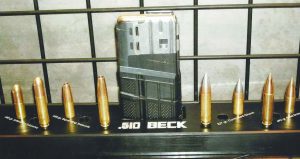
Various .510 Beck cartridges along with their respective projectiles. The magazine is a Lancer designed especially for the .510 Beck cartridge.
The three semi-auto Zenith rifles—Z-5, Z-41 and Z-43—are chambered for the 9mm Parabellum, 7.62mm NATO, and 5.56mm NATO cartridges, respectively. The rifles are sight equipped the same as the handguns. Finishes are black on the Z-5, the black, camo, and green options on the other two. Barrel lengths are 16” plus, with overall lengths ranging from 34” plus to 37.6”. The Z-41 rifle tips the scales at 9.5 pounds, with the others weighing less. All three rifles feature 10-round magazines; the Z-5 magazine is steel, the others polycarbonate.
MINOX has been known in the optics field for top quality products for decades. In 2016 the firm introduced ten new riflescopes, three new spotting scopes, and a new game camera. The new argon gas-filled ZP Tactical riflescopes—ZP8 1-8×24, ZP5 3-15×50, and ZP5 5-25×56—feature 34mm tubes, are watertight to a depth of 30 feet, and are priced at $2,899 each. Error-free parallax adjustment is available from 164 feet to infinity, and the reticle illumination can be adjusted in 11 levels of brightness. The field of view naturally shrinks according to the change in magnification. The largest field of view is found in the ZP8 at the 1X setting and the smallest field is at the 25X setting in the ZP5 model. The ZP8 also features an illuminated red dot reticle for day-time use.
The second series of Tactical riflescopes is the ZE line. Similar to the ZP line with argon gas filled tubes, the ZE scopes are waterproof only to 16.5 feet, but have other desirable features including innovative M* coated lenses. This M* coating consists of up to 21 layers, ensuring image sharpness, natural color rendition, excellent light transmission, and contrast. The ZE TAC 1-5×24 scope is fitted with an illuminated dot and circle reticle at the second focal plane, while the other two models—3-15×56 and 5-15×56—feature a finely dimmable twilight-illuminated reticle at the first focal plane.
Two of the new prism system spotting scopes—MD 60 Z and MD 80 X—are compact—up to 20% shorter than conventional straight tube scopes. Dustproof and waterproof to a depth of 16.5 feet, these scopes are rubber armored, tripod-adaptable, and feature wide-angle (60mm and 80mm) eyepieces. Magnification is from 12X to 40X and 20X to 60X. Priced at just under $1,400 and $1,500 respectively, these scopes can be obtained with a reticle for a C-note extra.
The ZX5 series of four Minox scopes feature argon gas purged 30mm tubes, are available with or without illuminated reticle. Priced from just under $500 to just under $750, this scope series provides a large field of view, making it ideal for the hunter.
Game trail cameras have been popular for the past decade or longer and Minox has a new DTC 700 camera that should be ideal for game trail and even security use. Battery life is said to be longer than six months, data is stored on a SD card or transferred using the USB port. With an integrated 9-volt port, the DTC 700 can be connected to the power mains on the outside of building for security use. Features of the DTC 700 include an infrared flash with range up to 49 feet in low light or twilight conditions; a black filter makes the flash invisible to people and animals alike. With a SMRP of less than $230, the camera comes with a fixing strap, USB cable, and instructions.
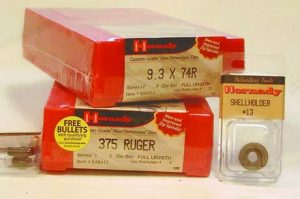
Hornady Manufacturing has loading die sets for most big-bore cartridges, including the 9.3mmx74R.
Hornady Manufacturing (hornady.com) always has a host of new products in their ammunition, components, or reloading equipment lines and 2016 is no exception. There is even a new bar type bench stool, with padded red vinyl-covered seat, complete with Hornady logo, and four new Hornady baseball style caps, including a Ladies Gray & Purple model; Purple, not pink or red. Another handy new item is the Ballistic Band for recording the ammunition, bullet weight and ballistic information; slip it on your wrist or the buttstock of rifle for ready reference.
Hearing, or the protection thereof, has become more important to shooters in the past few decades. (This shooter doesn’t recall any tale of market hunters wearing hearing protection, whether they were shooting bison or waterfowl in flocks. The .45-90, .50 Sharps, or a boat-mounted 4 or 2 gauge shotgun, or larger, did make a noise. Dedicated trapshooters may fire 10,000 or more 12 gauge shotshells per season, and most of them today do wear some form of hearing protection. Hunters often do not wear such projection. They should. The hearing they protect is their own.
The simplest form of hearing protection is the small compressible foam plugs. Available in a variety of colors, they are usually cone-shaped. Rolled between the fingers one such plug is inserted into the canal of each ear. They provide a minimum of protection. (This shooter recalls seeing some shooters in the distant past with handgun cartridge cases stuck in the ears, or wadded tissues, and even the white pith cut from the center of a dry corn cob. Such items may not be ideal, but may help. If you haven’t tried it, don’t knock it.)
Better are the muff or cup type which fit over each ear, and are connected by a band over the top of the hear, or behind the neck. (Best are the digital muffs, such as the Alpha Electronic M&P which compresses high Db noises and amplifies low lever sounds. It has a NRR 23 noise level rating and an audio input jack to play your favorite MP3 music.) The first such designs were large, and were sometimes referred to as Mickey Mouse ears. If they help shut out the noise of a jet engine being revved up, they work. At the 2016 Show, GSM-Walker Products, LLC (walkersgamear.com) was exhibiting Walker’s Pro-Low Profile 31 NRR passive folding muffs. Lightweight, with soft PVC ear pads, the 31 NRR muffs are rated ANSI S3.19, and when folded they are not much larger than a regulation softball.
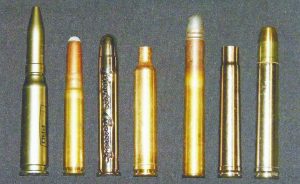
Left to right: In the Kynoch fixed ammunition and new brass for handloaders lineup: First not a cartridge but a Kynoch ballpoint pen; then a Kynoch 9mm Mauser round; plated commemorative 405 Winchester round (Theodore Roosevelt’s medicine gun cartridge); 6.5mm/378 Weatherby Magnum case; Kynoch 400 Straight 3”; plated Winchester 375 H & H Magnum case, and plated 458 Winchester Magnum cartridge.
This shooter has been a fan of Kynoch ammunition longer than he likes to remember. Probably because it was the only source, at that time at least, for 240 Vickers and 280 Ross cartridges. It was also the only source for the 470 Nitro Express, 500 Nitro Express, 577 Nitro, and others. However, not having any rifles chambered for the latter cartridges it didn’t really matter.
In recent years Kynoch cartridges have not been readily available. That may have changed. Gun Mountain (www.gunmountain.com) had an assortment of Kynoch cartridge boxes on display at the firm’s booth, and it’s assumed they can provide any Kynoch cartridge caliber currently being manufactured, if they do not have it in stock. If you are a big-bore shooter, and Federal, Hornady, or another US firm doesn’t load your favorite, try Gun Mountain.
Yankee Hill Machine (YHM.net) was another firm celebrating an anniversary—65 years—and they were exhorting the Billet Model-57 in Carbine and XL Carbine versions. Both are modified flat top AR-15 designs, with 16” barrel and YHM Slant Comp/Brake. The main difference in the two versions is the length of the top rail; it’s rifle length on the XL and mid-length on the regular carbine. A choice of three calibers—5.56mm, 6.8m SPC, and .300 BLK—is available, and the 5.56mm can be obtained with a 1:7 or 1:9 twist. (A third version—the Model 57 Limited Edition—is available with a Burnt Bronze finish.
Two other items YHM was promoting were their quick detachable suppressor mounts in 5.56mm or .30 calibers, and their 10/22 Integral Suppressor Barrel. The suppressed barrel is available separately, or as a complete rifle with Hogue Over-Moulded Stock.
Northwest S.R.L. (northwestbullets.com) is an Italian firm founded in 1995 to manufacture bullets, cases, and loaded handgun and rifle ammunition. (The firm also produces three 12-gauge slugs, types as sphere, deer, and wildboar.) The rifle cartridge line includes hunting, lead-free, and match grades. Rifle calibers range from the 222 Remington to 50 Browning, and bullet types include American brands, such as Barnes, Hornady, Nosler, and Sierra, plus Lapua, Norma, Prvi Partizan and a few others, in addition to the Northwest designs. Handgun calibers available range from the 32 ACP (7.65mm Browning) to the 50 Action Express, and include a couple not always readily obtainable—the 7.65mm Parabellum (.30 Luger) and 9x21mm IMI.
Among the less often seen rifle loads are the 6.5mmx55 Swedish, 7x64mm, 7x65R, 9.3x62mm Mauser, and the 408 Chey Tac. (The 408 is gaining a reputation as a long distance round and is loaded with a 420 grain Rocky Mountain design bullet.) Although Northwest doesn’t list loaded ammunition as available, the firm states they produce brass cases for a number of hard-to-find cartridges, such as the 22 Hornet, 6.5mm Carcano, 7.35x51mm Carcano, 7.65x53mm Argentine, 7.92x33mm (8mm Kurz), 8x56mm RS (Mannlicher), 8x60mm, 7.63mm Mauser, 9mm Makarov, and 41 Action Express, to name a few.
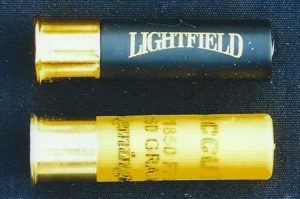
Lightfield mainly produces 12 and 20 gauge shotshell loads featuring sabot slugs. For 2016 the firm has several new .410-bore loads.
Lightfield Ammunition Corp. (lifld.com) has been producing ammunition for shotguns for more than a score of years, mainly in 12 and 20 gauge loads, such as their Sabot Shotgun Slug loads. For 2016 they have new Lightfield Wildlife Control and Home Defense loads in 12, and 20 gauge, plus .410-bore. The Less Lethal Home Defense loads feature rubber balls, slugs, or pellets.
Pro Mag Industries (progmagindustries.com) manufacture Made in America accessory or extra magazines for a host of handguns, rifles, and shotguns. The current line covers the arms of nearly three dozen brands from Beretta to Winchester, including Enfield, Galil, Kel-Tec, Ruger, SKS, Uzi, and Vepr. (Need a 10-round 303 British magazine for that old surplus Enfield #1, MKIII or #4 MKI rifle? Pro Mag makes them.) New for 2016 are more than two dozen new magazines for various Ruger, Smith & Wesson, Springfield, DPMS and Taurus firearms. Most of the magazines are manufactured of blued or black phosphated steel, but others are produced from Polycarbonate, Techapolymer or a combination. (Pro Mag manufactures more than magazines, such as forearm rails, magazine extensions, shotgun barrel clamps, pistol grip stocks for shotguns—and more. One such item is the ‘enhanced slide safety’ for the Mossberg 500/590 to replace the original plastic model. The Pro Mag safety is blackened stainless steel with more positive thumb contact.
Ballistic Products Inc (ballisticproducts.com) has been in the business of providing a components and equipment source for shotshell reloaders for four decades. Loading presses, lead shot, wads, empty hulls, roll crimpers, powders, loading blocks, and more are available from BPI, including loaded shotshells. Old timers in the shotgun game may remember when shotshells were roll crimped with a top wad featuring the shot size. BPI has added 12 gauge pre-numbered overshot wads for five shot sizes, 5 through 9. (Although only two sizes—24 and 32 gauge—are new, BPI has roll crimpers in nine sizes from 8-gauge down to .410-bore.
Most powder manufacturers publish reloading manuals at various intervals. They may be hardbound or softbound, annuals or every five or so years. BPI has at least a baker’s dozen manuals varying in length from the 26-page Coyote Manual to the newly updated 9th Edition Advantages Manual containing over 5,700 loads. (The 16-Gauge Manual is in its 8th edition, The Mighty Ten Manual is in its 6th edition, and the Status of Steel manual is in its 16th edition.) Other manuals cover slug loading, brass shotshells, Cheddite hulls, buckshot, ITX shot, and small bore shells—24, 28, and 32 gauge and .410-bore.)
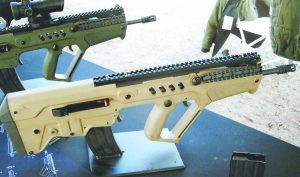
The IWI semi-auto Tavor X95 bullpup, the semi-auto civilian version of the X95 in use by the Israeli Defense Forces and Home Security agencies. Available in 5.56mm NATO, it should be available for the 300 Blackout prior to 2017.
Looking for something new to dampen the recoil of your favorite M1911, AR or AK? DPM Systems Technologies (dpmsystems.com) was exhibiting their new patented recoil reduction systems. For the M1911 the system consists of the world’s only progressive triple spring replacement guide rod; it does not require any modification of the pistol.
On the AK the recoil reduction is obtained via a telescoping multiple spring guide rod. For the AR, the system consists of a user adjustable replacement recoil buffer assembly. This AR unit can also be used on shotguns built on the AR platform.
Swiss-manufactured firearms are not unknown to American shooters, as the surplus military straight-pull M1889, M1911, and K32 models have been on the market at various times at reasonable prices. The early problem was availability of 7.5x55mm ammunition. Swiss Hammerli target rifles were imported by Stoeger Arms at one time, and possibly other firms. Calibers were limited usually to those cartridges considered suitable for target competition, including the Biathlon.
New to most US smallbore target shooters is the Bleiker rifle being imported from Switzerland by Pardini USA LLC (BleikerUSA.com). Chambered for the 22 Long Rifle the Bleiker is available in three versions—Challenger Lady, Challenger Metallic, and Model Walnut. The main difference in the three models is the stock. The Lady is designed for female shooter, the Walnut features a walnut stock and the Metallic stock is milled out of high-quality, tension-free aluminum. The stock balance can be varied with weights, which can be inserted at three different locations. The butt plate and cheek piece can be adjusted to individual needs, and the ergonomic grip, which can be turned, tilted and pushed in any direction, is available in four sizes.
Featuring a turn-bolt rather than a straight-pull action the heart of the Bleiker is the benchrest style action with patented barrel connector. The bolt is specially coated, and dry-firing can be done via a permanent firing pin absorber. Ignition time is stated to be very fast, with ignition at the bottom of the bolt face instead of the top or on the side. A precision Match-grade trigger is standard, and the top of the receiver is fitted with a long sight rail.
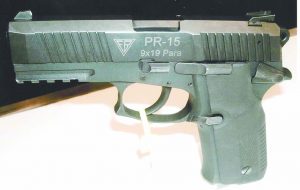
The new 9mm Polish Radom PR-15 pistol. The PR-15 appears to be an excellent design. Think of it as the circa-1935 WWII Radom VIS pistol updated fourscore years into the 21st century.
The M1911 has been around for 105 years, and it’s difficult to improve on John M. Browning’s original design. (If you consider the predecessor—the M1905—chambered for the 45 ACP cartridge, the basic design has been around for 111 years.) The original straight mainspring housing went arched in the A1, and back and forth depending on tastes and the manufacturer; the hammer has been slimmed, bobbed, etc. The recoil spring has seen several transitions, the trigger guard squared, the grip safety reshaped, the frontstrap stippled, grooved, checkered, and the band played on. Tightening the slide usually improved accuracy on the target range, but did not necessarily make the M1911 more accurate under combat conditions. An adjustable rear sight and a higher front blade helped when time was available for sighting, but in close quarters condition of point-n-pull, who’s sighting? (Sgt. York did well with the M1911 in World War I, and it was strictly G.I.)
Vista Outdoors (vistaoutdoor.com) is a conglomerate of nearly three dozen firm, from Alliant Powder to Weaver Scopes, including CCI, Federal Premium Ammunition, RCBS and Savage Arms. For 2016 Savage Arms has added a host of rifles and shotguns, from the Takedown Model 42 Over/Under combo, to the Stevens S1200 semi-auto 12 gauge shotgun. (The 22/410 Savage Combo has been around since just prior to World War II when it was introduced with the Tenite stock and forearm as the Model 24 with the selector button on the side of the frame. The latest model only vaguely resembles the original, but it is still a handy small arm and great for backpacking, where legal.)
In the rimfire rifle line there are two new A17 autoloading models chambered for the 17 HMR cartridges. Both feature heavy—bull type—barrels, and gray wood laminate stocks, one Sporter and one Target Thumbhole Sporter. They feature delayed-blowback operation. There is also a new A22 autoloader based on the A17, but chambered for the 22 WRM cartridge. It features the AccuTrigger, an aluminum receiver, 10-round rotary magazine and black sporter style synthetic stock.
Three new bolt action B.MAG rifles chambered for the 17 Winchester Super Magnum cartridges have been added. All resemble the centerfire models with thread-in barrel headspacing, rear locking lugs, but feature rotary magazines. Dubbed the Beavertail, Heavy Target, and Sporter models, the rifles feature a synthetic and laminated hardwood stocks, respectively, and come without sights. Savage centerfire rifles include a new Model 16/116 Lightweight Hunter bolt action weighing under six pounds, without sights, and nine new models chambered for the 6.5mm Creedmoor cartridge. All the rifles feature the AccuTrigger
The Stevens shotgun line includes a couple of new 12 gauge models, the 320 Waterfowl Camo pump model and the S1200 semi-auto. Both models feature ventilated barrel ribs and interchangeable choke tubes. The 320 has dual action bars, a rotary bolt system, and a five-round shell capacity. The S1200 is advertised as the firm’s first semi-automatic shotgun, which is a bit of an error. It may be the firm’s first gas-operated model, but the firm produced a Browning long-recoil autoloader some +/- 50 years ago. It had a rounded duralumin receiver with black anodized finish, and not the hump of the Browning Auto-5, but it was Savage/Stevens.

The new European American Armory (EAA) 12-gauge self-loading shotgun with detachable box magazine.
European American Armory (EAA.com) showed a prototype autoloading bullpup rimfire rifle a couple of SHOT Shows back, but the production rifle has now arrived. Built by Tanfoglio as the firm’s first long gun, the Appeal Rifle weighs less than five pounds and is available chambered for the regular 22 Long Rifle or the 22 WMR round. Magazine capacity is 10 rounds in either caliber. Overall length of the Appeal is 29.5” with an 18” barrel. The frame is polymer, as is the stock, which is adjustable for length of pull. Other features of the Appeal include a Picatinny top rail with adjustable open sights, a removable muzzle break with light/laser rail on the underside, a firing pin block safety, and the rifle is ambidextrous, with the ability to convert for either right or left-hand shooters.



